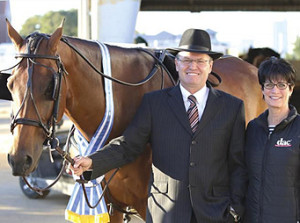The Benefits of Pleasure Driving Across Disciplines
Click here to read the complete article202 – January/February, 2018
By Megan Ulrich
 Whether it’s the jaw-dropping craftsmanship of the cart, the gleam of the harness, the beauty of the horse’s movement, or the clear, trusting relationship between horse and driver, there is something both admirable and quietly elegant about Pleasure Driving. Though, historically, entries in this class had been stock-type, short-strided, or “peggy” movers, the winners in recent years exhibit a quality of movement that’s not only desirable in front of the cart but is rewarded under saddle as well. These are horses with long, flowing strides, strong toplines, and hind end impulsion. However, what you might not know is that the behind-the-scenes training that goes on to prepare horses for Pleasure Driving can have benefits for numerous other disciplines.
Whether it’s the jaw-dropping craftsmanship of the cart, the gleam of the harness, the beauty of the horse’s movement, or the clear, trusting relationship between horse and driver, there is something both admirable and quietly elegant about Pleasure Driving. Though, historically, entries in this class had been stock-type, short-strided, or “peggy” movers, the winners in recent years exhibit a quality of movement that’s not only desirable in front of the cart but is rewarded under saddle as well. These are horses with long, flowing strides, strong toplines, and hind end impulsion. However, what you might not know is that the behind-the-scenes training that goes on to prepare horses for Pleasure Driving can have benefits for numerous other disciplines.
Chuck Briggs rattles off a laundry list of improvements he’s seen in his performance horses after sending them through Brian Holmes’s driving training. “They’re very acceptable to a lot of things, and they learn what work is. They learn to really pull, so it makes young ones stronger and develops their muscles. They also learn to stay straight in their bodies, and they really learn how to trot up.”
Multiple World and Congress Champion Pleasure Driving trainers, Kevin Dukes and Brian Holmes, both train driving horses that also show in Under Saddle events. Both trainers speak that know their job and, because of the physicality of pulling a cart, emerge stronger movers after their training.
Hind End impulsion
Perhaps one of the greatest benefits seen in driving horses is stronger impulsion. That hind end momentum makes for a freer, lighter front end and a stronger topline, all traits rewarded both in Pleasure Driving and Under Saddle events.
“There’s a physical aspect to pulling a cart that strengthens them from behind. If a horse is pulling a cart correctly, they’re pushing from behind,” Dukes says. “When a horse first starts pulling, they don’t totally understand how the mechanics work; most of them want to pull from the front. At that point, you’re not really helping their movement. But, as they learn to maneuver and steer, they learn to push from behind rather than pull, and that does help with impulsion, and it frees up the shoulders and front end.”
Click here to read the complete article202 – January/February, 2018










